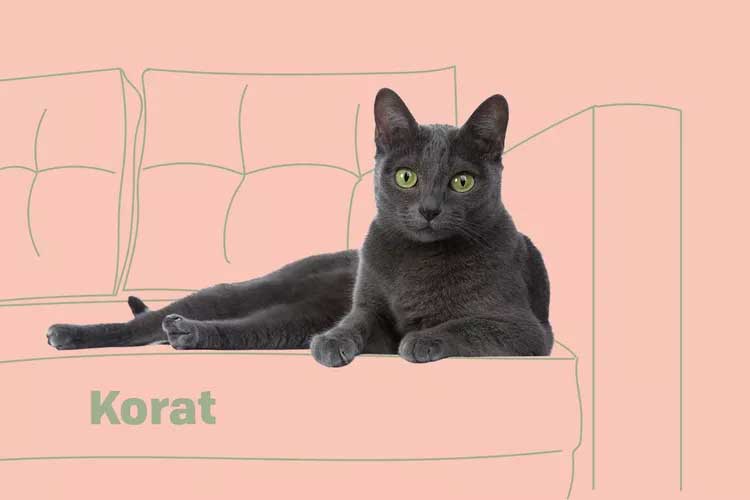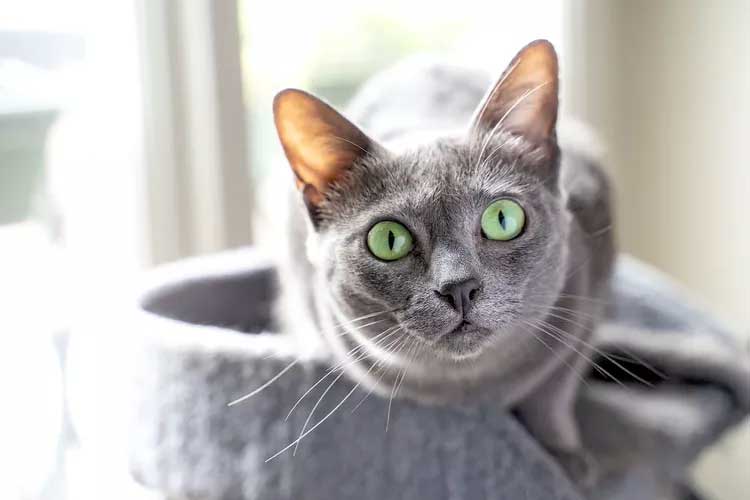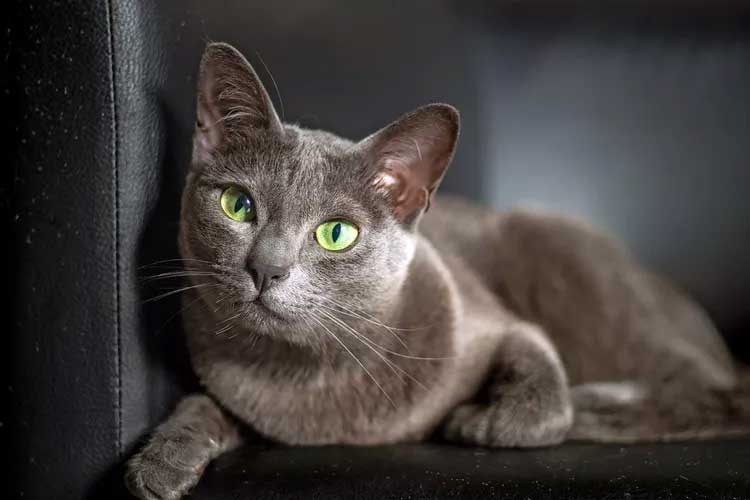Regal in bearing and possessing a stunning, shimmering blue coat, the Korat is a gorgeous, affectionate “good luck cat” for most households.

Korat Overview
| OFFICIAL NAME | Korat |
| COMMON NAME | Korat |
| PET HEIGHT | 9 to 13 inches |
| PET WEIGHT | 6 to 10 pounds |
| LIFESPAN | 10 to 15 years |
| GOOD WITH | cats, children, families, seniors |
| TEMPERAMENT | affectionate |
| INTELLIGENCE | high |
| SHEDDING AMOUNT | infrequent |
| PLAYFULNESS | medium |
| ENERGY LEVEL | calm |
| VOCAL LEVEL | when necessary |
| COAT LENGTH | short |
| COLORS | blue / gray |
| PATTERNS | solid |
| OTHER TRAITS | easy to groom, easy to train, friendly toward humans, good for first-time pet owners, good lap cat, hypoallergenic, strong loyalty tendencies, tolerates being picked up |
The Korat is one of the oldest, most stable breeds in the world. Revered in their native Thailand as a "good luck cat," Korats are traditionally given in pairs, with special importance when given to brides as wedding gifts, according to the Korat and Thai Cat Association (KTCA).
It can be easy to see why the breed has been beloved in their homeland for so many centuries. Korats have one of the most beautiful coats in all the cat kingdom and are intelligent, loving lap cats who develop strong bonds with their families.
Appearance
Korats come in just one color: a beautiful blue with silver-tipped fur that gives them a shimmery, halo-like appearance, according to the Cat Fanciers' Association (CFA). They are a small-to-medium breed with a low amount of body fat, large forward-facing ears and round, beautiful, peridot green eyes.
The Korat is sometimes referred to as "the cat with five hearts" because, in addition to the one beating in their chests, their heads create a distinctive, Valentine's heart shape when viewed from the front as well as from the top. Their noses are also heart-shaped, with a visible fourth heart shape recognizable in the musculature in their chests, right between their front shoulders.
Temperament
A deeply intelligent cat, the Korat is also a very thoughtful family member. Korats are more laid-back than most cats. They'll find time to play and be active, but they're every bit as happy to cuddle in their owner's lap."Korats form deep bonds with their human family and are fond of cuddling," says Sarah Wooten, DVM. "They are very smart and enjoy food puzzles, enjoy children if properly socialized, [and enjoy] training and games."

They can be skittish or aloof around strangers, but they will always seek out their family for safety and watch the proceedings from there.
Korats can do well in multi-pet homes but tend to do their best with other Korats. However, thanks to their social, laid-back nature, Korats can and do learn to get along with other cats as well as cat-friendly dogs, as long as socialization and introductions are handled patiently. Regardless of what kind of other animals are in the house, make sure there are enough toys to go around.
Because they are so social, the Korat is not a cat who will be happy spending long periods of time alone. If you work from home or have multiple pets, everything should be good—but a Korat left alone can develop separation anxiety and some undesirable behaviors as a result.
Living Needs
The Korat is very happy being a lap cat and will contentedly follow her preferred family members around the house all day. Making sure there are toys around for when she wants to play is important. Like all cats, your Korat will also love scratching posts to sharpen her claws on, cat trees to climb, and window hammocks where she can chatter at birds all day.When it comes to living size or temperature considerations, the Korat is a pretty adaptable animal. As long as she knows where to eat and where to poop, she's going to be pretty happy wherever you are, whether that's a multi-story home or studio apartment.

The Korat's beautiful coat also doesn't tend to lose hair much at all, making her a "tolerable" choice for people with hair allergies, the CFA says. But even with low-shedding cats such as the Korat, it is important to remember no cat is technically completely hypoallergenic and allergies can still persist. Before bringing home a Korat kitten, spend time with the breed to see how your allergies react.
"The allergens that people are reacting to are in the saliva in fluids, rather than the hair itself," says Carol Margolis, DVM, DACT, of the Gold Coast Center for Veterinary Care on Long Island, N.Y. "Even in a lab setting, with the use of PPE in academic circumstances, people can irritate existing allergies or even develop new allergies over prolonged exposure."
Care
Korats don't need a lot of grooming. Their shimmery coat is a very low-shedding single coat of short fur, so brushing them lightly once a week will keep them looking great. Giving some attention each week to their ears and teeth will help keep them healthy in the long run, but that's going to be about as far as your Korat grooming will ever have to go. And obviously, make sure her litter box is always kept tidy.Health
As you might expect from a naturally occurring breed that's nearly 800 years old, the Korat has a pretty clean bill of health, according to the KTCA. That said, Korats can be susceptible to some common cat maladies.
"As with all cats, Korats are susceptible to obesity and dental disease," Wooten says. "And you can go a long way towards preventing diseases by just keeping your Korat fit and trim, feeding the highest quality food you can afford, and keeping their teeth sparkly and clean."
Older Korats are also susceptible to kidney disease and hyperthyroidism, Wooten says. Some Korats can have a sensitive stomach, so keep an eye out for frequent vomiting or diarrhea. Wooten says these cats benefit from eating a sensitive stomach cat food and avoiding human table food or sudden diet changes.
History
The first documented mention of the Korat comes from the "Treatise on Cats", composed sometime around 1350. The book outlines 17 "good luck cats," including the Korat. While not greatly detailed, the illustration given in the book depicts a cat that is remarkably similar to the Korat we see today, indicating the breed has changed very little over nearly eight centuries.
Named for the Korat province in Thailand, the Korat cat is a traditional gift among the Thai people and thought to be a symbol of prosperity for newlyweds. Until the mid-20th century, Korats were never sold; they were only given as gifts.
Fittingly, the first Korats brought to the United States were a pair of cats who were gifted to the owners of the Cedar Glen Cattery in Oregon in 1959, according to the CFA. Virtually all American Korats can trace their lineage back to that first breeding pair, the CFA says. The breed was accepted for Champion status by the Cat Fanciers' Association in 1966.
Fun Facts
The Korat's role in Thai society as a gift cat was so important that, until the mid-20th century, they were never sold, only given as gifts.Korats with crimped or striped tails were often considered especially lucky, according to the CFA.
Their Thai name, Si-Sawat, comes from their coat and literally means "grayish-blue," while "Sawat" means prosperity.